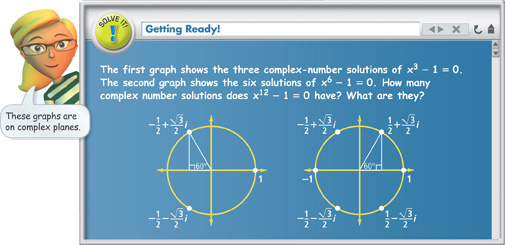5-6 The Fundamental Theorem of Algebra
Objective
To use the Fundamental Theorem of Algebra to solve polynomial equations with complex solutions
 Lesson Vocabulary
Lesson Vocabulary
- Fundamental Theorem of Algebra
You can factor any polynomial of degree n into n linear factors, but sometimes the factors will involve imaginary numbers.
Essential Understanding The degree of a polynomial equation tells you how many roots the equation has.
It is easy to see graphically that every polynomial function of degree 1 has a single zero, the x-intercept. However, there appear to be three possibilities for polynomials of degree 2. They correspond to these three graphs:



Table of Contents
- 5-1 Polynomial Functions
- 5-2 Polynomials, Linear Factors, and Zeros
- 5-3 Solving Polynomial Equations
- 5-4 Dividing Polynomials
- 5-5 Theorems About Roots of Polynomial Equations
- 5-6 The Fundamental Theorem of Algebra
- 5-7 The Binomial Theorem
- 5-8 Polynomial Models in the Real World
- 5-9 Transforming Polynomial Functions





